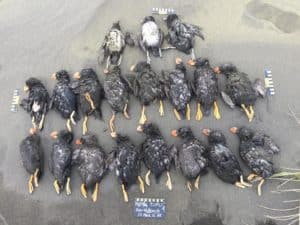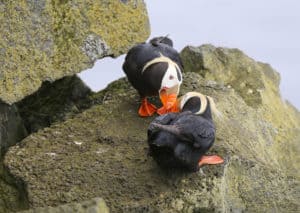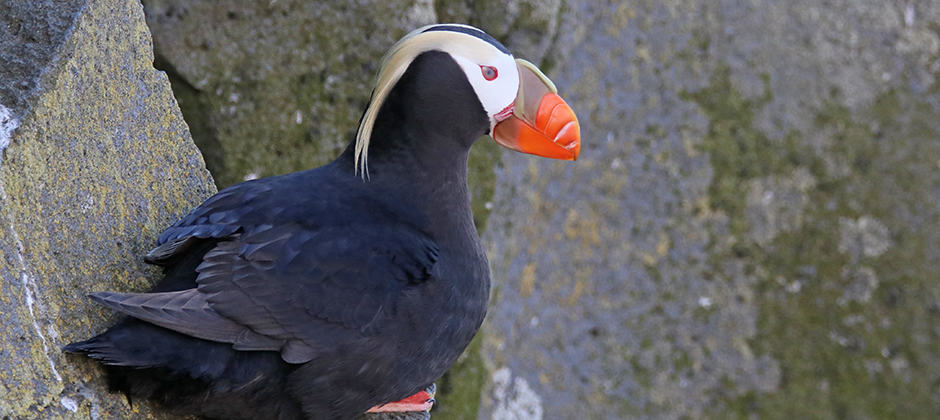Share this article
Starvation prompted mass puffin die-off
It was the end of October 2016 when the first reports of dead puffins and auklets began trickling in on the small Pribilof island of St. Paul. Local Aleuts had begun to find seabirds washed up on the north and southeast beaches of the island, located in the Bering Sea off the western coast of Alaska. The sightings prompted wildlife technicians who monitor for dead or injured birds began to watch the coastline more closely. By the following January, about 360 tufted puffins (Fratercula cirrhata) and crested auklets (Aethia cristatella) turned up dead on St. Paul, some 1,000 to 1,500 miles from their normal wintering area long after they should have passed by on their journey south.
“There are particular times of year when birds die,” said Lauren Divine, Director of the Aleut Community of St. Paul’s Island Ecosystem Conservation Office and a co-author of a study describing the die-off published in PLOS ONE. “They don’t fledge, or they don’t make it over the winter.”

Nineteen tufted puffins were found on North Beach, on the island of St. Paul, on Oct. 19, 2016.
©Aleut Community of St Paul Island Ecosystem Conservation Office
People in the community had a pretty good idea which birds turned up dead and when they would likely appear, but they had never seen anything close to the number of tufted puffins washing up dead on the shore.
“They were really late,” said Julia Parrish, a professor of ocean fishery sciences at the University of Washington and the executive director of the Coastal Observation and Seabird Survey Team (COASST), an organization that monitors U.S. seabird deaths from the Arctic Circle in Alaska to northern California (COASST partners with a Canadian organization that does similar work called British Columbia Beached Bird Survey, or BCBBS, as well as two organizations in California: BeachWatch and BeachCOMBERS), often with the help of citizen scientists.
Divine and her Aleut colleagues found that 87% of the dead birds were tufted puffins. They shipped a few carcasses off to a federal lab, but tests found no trace of disease, toxins or other pollution that may have led to the seabirds’ deaths.
“The lab reports came back indicating that the birds were extremely thin — emaciated — basically starving to death,” said Parrish, a co-author on the study.
Puffins usually passed by the Pribilof Islands by November on their way south, through the Aleutian Islands and out into the open North Pacific. They winter in the open ocean, where they lose their flight feathers and are flightless for several weeks as they grow a new set, diving underwater for food, much as penguins do.
The birds that washed up on St. Paul were already in molt, leading Parrish to believe that they couldn’t make it far enough south in time that year.

Tufted puffins are important for the Aleut community on the island of St. Paul.
©Antonio Hanson
“Our interpretation is they ran out of gas,” she said. “They had to start molting, and they starved to death.”
Divine said that puffins are important to the local community, who used to harvest them. “It was something that used to be an important food, but now it’s more valued for its presence,” she said. “It was pretty upsetting for the community to see.”
If Parrish and her colleagues were right, far more birds than the ones washed up on the shores of St. Paul likely died. Researchers ran models based on the tides, hourly wind data and surface water temperature to estimate between 3,000 and 8,000 birds died.
Why did they starve? Parrish said it might have to do with a warmer Bering Sea, which began to ice over much later than usual that season. Researchers believe the warmer waters were responsible for a recorded drop in forage for the birds, including fish and zooplankton, which made the puffins work harder for less food. “You’re living closer to the edge, hence more puffins dying,” she said.
Researchers still aren’t entirely sure whether the puffins stayed too long in their summer grounds because the cold weather came late, or whether the puffins just couldn’t get enough food after breeding, but this mass die-off is just one of a number of similar events affecting seabirds in the area in the past few years.
In the winter of 2015-2016, large numbers of common murres (Uria aalge) washed up on the shores of Alaska, possibly due to warmer water conditions prompted by el Niño, while murres and other seabirds have being dieden masse in other years, according to Alaska Nature and Science.
“We’ve seen a wave of mass seabird mortality events starting in 2014 and continuing to the present,” Parrish said. “I would say that’s fairly damning albeit indirect evidence [of climate change].”
Divine said that the local Aleut community still harvests eggs from some of these seabirds, and that die-offs have a huge effect.
“This is pretty devastating for the culture,” she said.
Header Image: Hundreds of tufted puffins were found washed up dead on beaches in the Pribilof Islands of Alaska in fall and winter of last year. ©Carly Bourdukofsky








